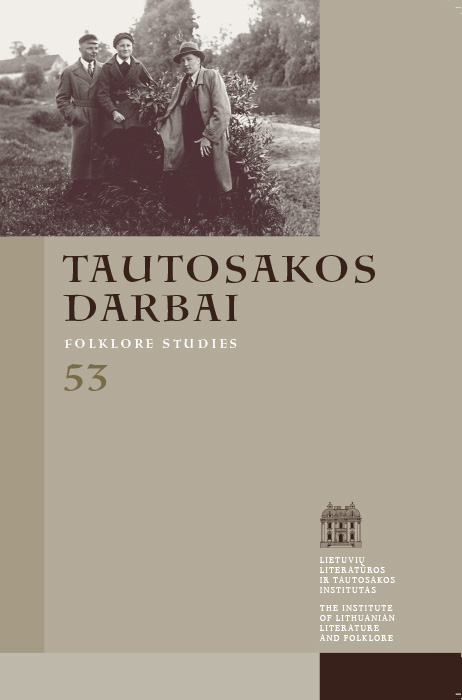Greimo mitologijos tyrimų takais
Santrauka
Nors nuo Algirdo Juliaus Greimo mitologijos studijų Apie dievus ir žmones (1979) ir Tautos atminties beieškant (1990) pasirodymo jau praėjo keli dešimtmečiai, bet iki šiol nėra plačiau aptartas jo mitologijos tyrimų kelias. Straipsnyje pateikiama Greimo mitologijos darbų (įskaitant ir skelbtuosius prancūzų kalba) chronologinė apžvalga, išryškinamos jo mitologijos studijų prielaidos ir siekiai, atskleidžiamas Greimo požiūris į mitologijos tyrimų būklę Lietuvoje. Atliktas tyrimas leidžia teigti, kad lietuvių mitologija Greimui buvo ne tik bendrųjų semiotikos tyrimų „bandomasis laukas“, bet ir galimybė realizuoti save kaip kultūros istoriką ir religijotyrininką, o kartu, jo paties žodžiais tariant, „atiduoti skolą Lietuvai“. Ši sugrąžinta „skola“ tebelaukia deramo įvertinimo ir pradėtų darbų tąsos.
Atsisiuntimai
Skaitomiausi šio autoriaus(ų) straipsniai
- Daiva Vaitkevičienė, Užkalbėti ir melsti: švelnioji galia lietuvių užkalbėjimuose , Tautosakos darbai: T 64 (2022)
- Daiva Vaitkevičienė, „Užkalbėjimas“, „žadėjimas“ ir „vardijimas“: eminės terminologijos metmenys , Tautosakos darbai: T 67 (2024): Tautosakos darbai
- Austė Nakienė, Daiva Vaitkevičienė, Vita Džekčioriūtė-Medeišienė, Gražina Kadžytė, Aurimas Bačiulis, Vida Savoniakaitė, Lina Būgienė, Kronika , Tautosakos darbai: T 55 (2018)
- Daiva Vaitkevičienė , Prie gyvybės medžio šaknų: Marija Gimbutienė šeimos moterų draugijoje , Tautosakos darbai: T 62 (2021)
- Daiva Vaitkevičienė, Midus baltų visuomenėje: nuo bitininkų iki diduomenės , Tautosakos darbai: T 51 (2016)
- Daiva Vaitkevičienė, Rolandas Petkevičius – lietuvių etnopsichiatrijos tyrėjas , Tautosakos darbai: T 54 (2017)
- Daiva Vaitkevičienė, Šventasis sambūvis: laukiniai gyvūnai žemdirbio sodyboje , Tautosakos darbai: T 56 (2018)
- Daiva Vaitkevičienė, Dainius Razauskas, Būti mitologu – su širdimi ir iš širdies. Daivos Vaitkevičienės pokalbis su Dainiumi Razausku , Tautosakos darbai: T 60 (2020)
- Daiva Vaitkevičienė, Knyga apie unikalų latvių užkalbėjimų rinkinį , Tautosakos darbai: T 61 (2021)
- Daiva Vaitkevičienė, Pratarmė , Tautosakos darbai: T 62 (2021)
